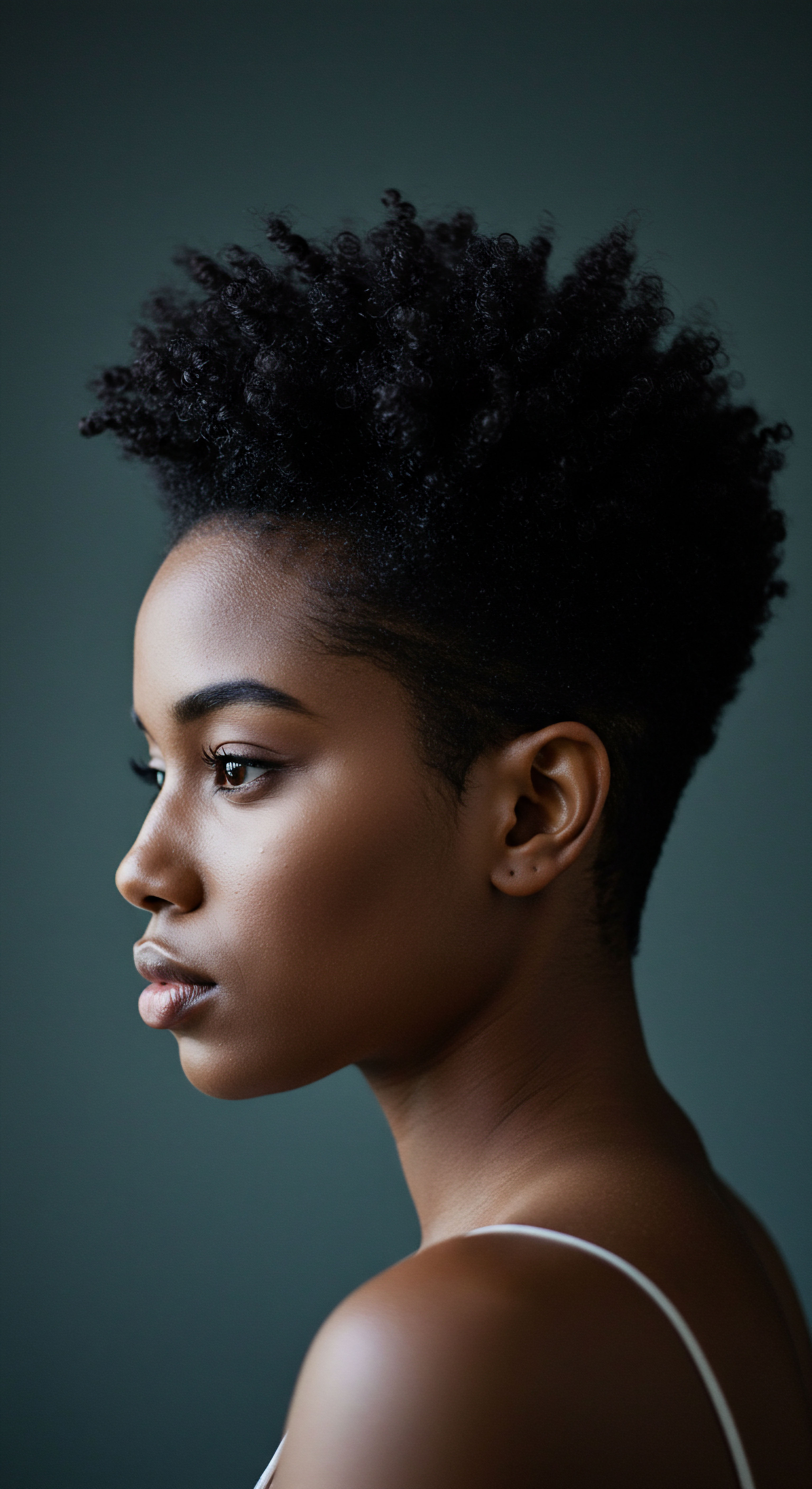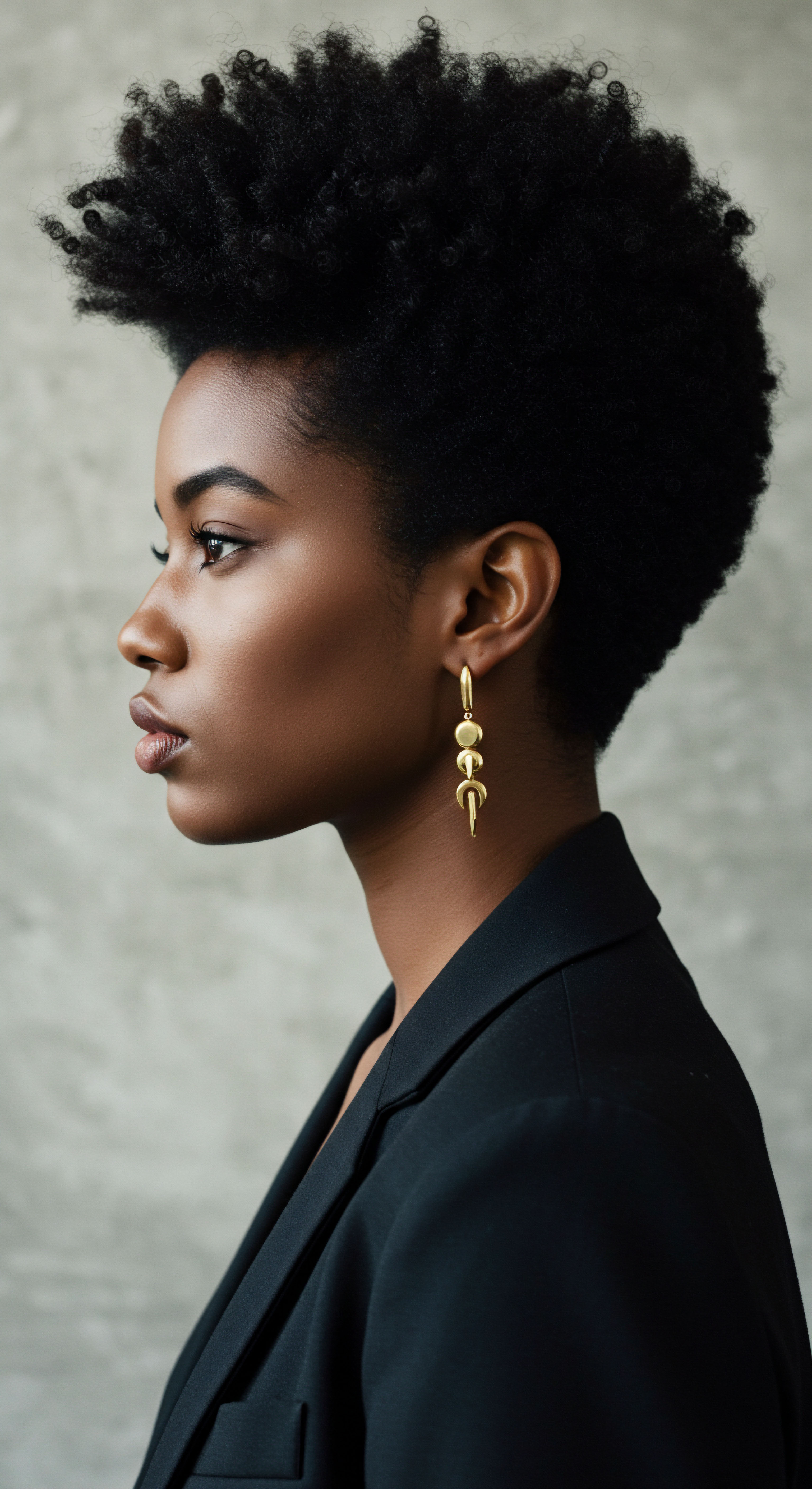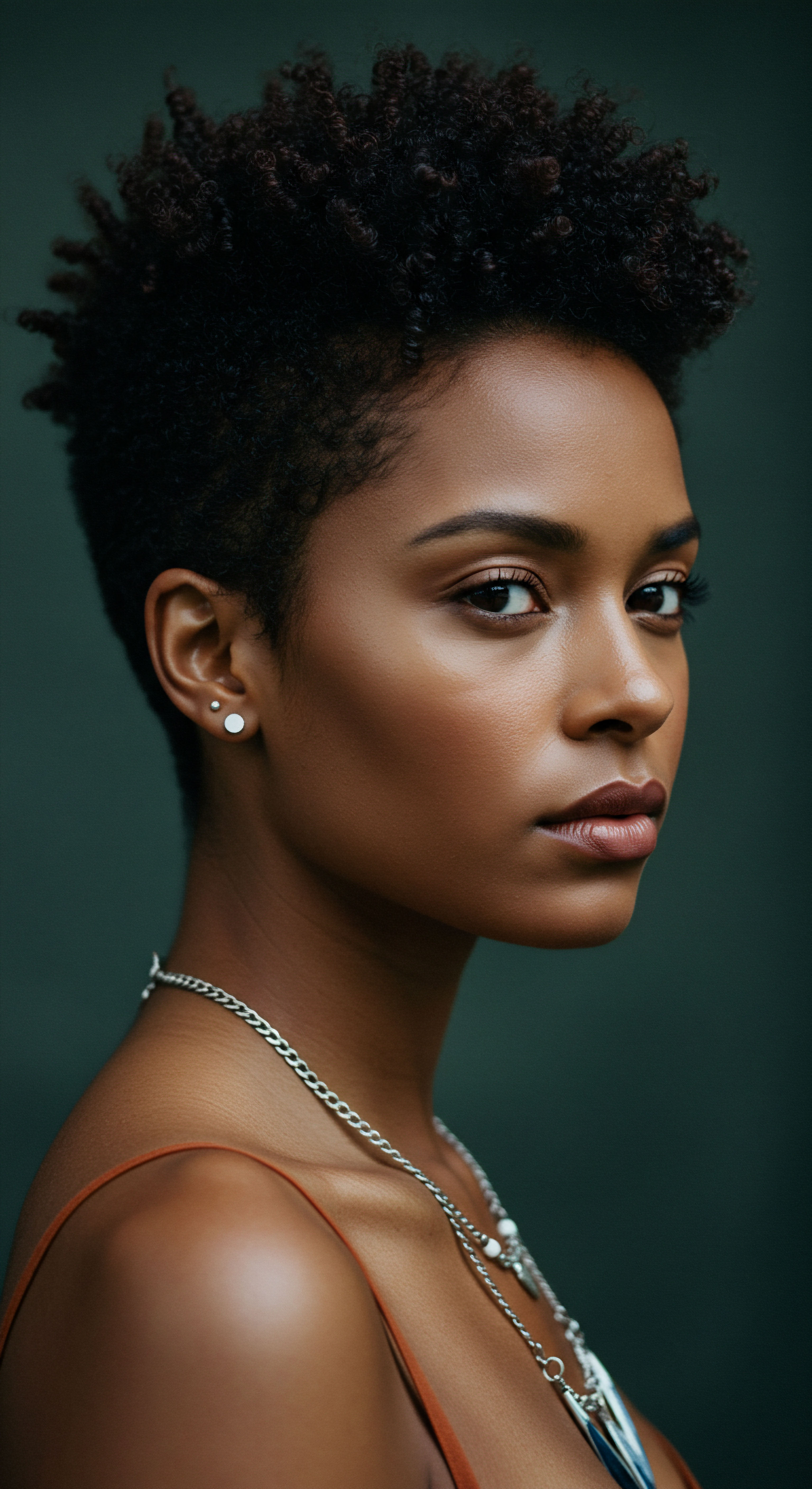
Roots
The quiet hours of the night hold a profound sway over the vitality of our coily strands. As the world outside settles into slumber, our hair, too, engages in a delicate dance with its immediate surroundings. Many a morning begins with a silent assessment in the mirror, a gentle touch to the hair, and a question lingering in the air ❉ what transpired while we slept?
For those with the glorious crown of coily hair, this nightly interaction with the bedroom environment is not merely a matter of convenience; it is a fundamental determinant of overnight well-being, shaping the very texture and resilience of each curl. Understanding this intimate relationship requires a journey into the intrinsic nature of coily hair itself, a recognition of its unique architecture and needs, before we can truly appreciate the silent impact of our sleeping spaces.

The Architecture of Coily Hair
Coily hair possesses a distinctive structural blueprint, setting it apart from other hair types. Each strand emerges from an elliptical, often flattened, follicle, dictating its characteristic tight curl pattern. This unique shape causes the hair shaft to make numerous bends and twists along its length.
Unlike straighter hair, where natural oils from the scalp can easily glide down the shaft, the journey for these protective lipids along a coily strand is far more arduous. This inherent design contributes to a predisposition for dryness, as the hair’s own moisturizing agents struggle to reach the ends.
Furthermore, the diameter of a coily hair strand is not uniform; it often varies along its path, creating points of reduced strength. These variations, coupled with the numerous twists, render coily hair more susceptible to breakage from external forces. The outermost layer, the cuticle, comprises overlapping scales.
In coily hair, these scales may naturally be more raised or open, which, while contributing to the hair’s beautiful volume, also allows for easier entry and exit of moisture. This openness, while beneficial for absorbing conditioning agents, also means that moisture can escape with greater ease, leading to dryness if not properly managed.
Coily hair’s distinct structural design, characterized by elliptical follicles and varying shaft diameters, naturally predisposes it to dryness and increased susceptibility to breakage.

Why Coily Hair Needs Special Overnight Attention
Considering this inherent structure, the sleeping environment becomes a critical factor in maintaining coily hair health. During sleep, our bodies undergo periods of movement, leading to friction between our hair and the surfaces it rests upon. For hair with a more uniform, closed cuticle, this friction might result in minimal disturbance.
However, for coily hair, with its delicate structure and often open cuticle, the consequences of such friction are far more pronounced. Each toss and turn can cause the raised cuticle scales to catch on rough fabrics, leading to tangles, breakage, and the dreaded “bed head” that signifies a loss of moisture and curl definition.
The nocturnal hours also present an extended period where hair can lose moisture to the surrounding air or absorb unwanted moisture from it, depending on the ambient humidity. For hair already prone to dryness, a dry bedroom atmosphere can exacerbate moisture loss, leaving strands brittle and less supple. Conversely, excessive humidity can cause the hair shaft to absorb too much water, leading to swelling, frizz, and a loss of the hair’s carefully crafted shape. Understanding these foundational principles of coily hair’s anatomy and its interaction with the environment sets the stage for appreciating the wisdom behind specific nighttime rituals.
To visualize the distinct characteristics of coily hair compared to other types, consider the following table which highlights key anatomical differences:
| Hair Characteristic Follicle Shape |
| Coily Hair Elliptical or Flattened |
| Straight Hair Round |
| Hair Characteristic Curl Pattern |
| Coily Hair Tight Coils, Zigzags |
| Straight Hair No Curl |
| Hair Characteristic Shaft Diameter |
| Coily Hair Varies Along Length |
| Straight Hair Uniform |
| Hair Characteristic Cuticle Layer |
| Coily Hair Often More Raised |
| Straight Hair Typically Flat, Smooth |
| Hair Characteristic Sebum Distribution |
| Coily Hair Difficult, Slower Travel |
| Straight Hair Easy, Even Travel |

Ritual
As the day winds down and thoughts turn to rest, a quiet shift in our hair care approach begins. The realm of ritual, a space of thoughtful repetition and gentle intention, offers practical wisdom for preserving coily hair’s overnight health. It acknowledges that true hair care extends beyond daytime styling, reaching into the silent hours where restorative practices truly make a difference.
This section invites us to consider the conscious choices and soft habits that can transform a restless night for our strands into a period of gentle preservation and renewed vibrancy. It is about understanding the applied wisdom that protects and nurtures, ensuring that our hair awakens refreshed, ready to greet the day.

Protective Hairstyles for Night
The manner in which coily hair is gathered before sleep plays a significant role in minimizing friction and maintaining curl integrity. Simply allowing hair to roam free on a pillow can lead to tangles and breakage, as individual strands rub against each other and the bedding. Protective styles serve as a shield, safeguarding the hair from mechanical stress.
- Pineappling This technique involves gathering all hair loosely at the very top of the head, creating a high, loose ponytail. The aim is to position the hair so that the curls are stacked, minimizing contact with the pillow. A soft, satin scrunchie or a wide fabric band works best, as tight elastic ties can cause creases or breakage. This method allows air circulation while keeping curls largely intact.
- Loose Braids or Twists For longer coily hair, dividing it into a few large, loose braids or twists before bed can prevent tangling and preserve definition. The key is to avoid tightness, which can strain the scalp and hair follicles. These styles keep the hair contained, reducing the surface area exposed to friction and helping to maintain the curl pattern without compression.
- Buns and Knots A loose bun, particularly a high bun or a series of small buns, can offer similar protection. The goal remains gentle containment, preventing widespread friction and matting. These styles help to keep the hair elevated and away from constant contact with bedding.

The Material Matters
The surface on which coily hair rests overnight holds substantial influence over its condition. Traditional cotton pillowcases, while comfortable for sleeping, possess a fibrous texture that can be abrasive to delicate hair strands. Their absorbent nature also draws moisture from the hair, contributing to dryness.
A thoughtful shift to materials like silk or satin offers a remarkable improvement. These fabrics feature a smooth, tightly woven surface that allows hair to glide effortlessly, significantly reducing friction. This reduction in friction translates directly to less breakage, fewer tangles, and preserved moisture.
Beyond pillowcases, the use of hair coverings provides an additional layer of defense.
- Satin or Silk Bonnets These caps completely enclose the hair, creating a protective cocoon. They prevent hair from rubbing against any bedding material, regardless of the pillowcase, and help to seal in moisture. The smooth interior surface ensures minimal disturbance to the curl pattern.
- Silk or Satin Scarves A scarf offers versatility in how hair is wrapped and secured. It can be tied to accommodate various protective styles, providing a custom fit and ensuring all strands are protected. The fabric’s inherent properties work to maintain hydration and reduce frizz.
Selecting smooth, non-absorbent materials like silk or satin for pillowcases and hair coverings significantly diminishes friction and moisture loss, safeguarding coily hair overnight.

Nighttime Product Application
The application of appropriate products before bed can fortify coily hair against environmental stressors and support its natural moisture balance.
Before bedtime, a light application of a moisturizing leave-in conditioner or a sealing oil can act as a barrier, locking in hydration and protecting the hair from the dry air often present in bedrooms. For hair prone to extreme dryness, a heavier cream or butter might be considered, providing a sustained release of moisture throughout the night. The aim is to create a supple, well-lubricated environment for the hair, reducing its susceptibility to friction-induced damage. The choice of product should align with the hair’s porosity and current moisture needs, ensuring the hair feels soft and resilient, not heavy or greasy.
Consider a typical nighttime care table:
| Practice Protective Styling |
| Benefit Minimizes tangles, preserves curl shape, reduces friction |
| Consideration Use loose, soft ties; avoid tightness |
| Practice Silk/Satin Pillowcase |
| Benefit Reduces friction, retains moisture, prevents frizz |
| Consideration A worthy investment for long-term hair health |
| Practice Bonnets/Scarves |
| Benefit Complete hair enclosure, ultimate friction barrier, moisture retention |
| Consideration Ensures consistent protection regardless of sleep movement |
| Practice Leave-in Products |
| Benefit Locks in hydration, adds slip, fortifies strands |
| Consideration Match product weight to hair's porosity and dryness |

Relay
The deeper currents of understanding, where scientific observation meets cultural resonance, truly reveal the comprehensive impact of the bedroom environment on coily hair. This section delves into the intricate interplay of physical forces, atmospheric conditions, and the historical wisdom that informs modern protective practices. It is a space where the subtle complexities of our nocturnal surroundings are illuminated, offering a profound appreciation for the dedicated care coily hair requires, not just for its physical integrity, but for its enduring cultural significance. We step beyond the immediate, to consider the interconnected systems that shape overnight hair health.

How Does Friction Affect Coily Hair at Night?
The mechanical stress exerted on hair during sleep, primarily through friction, stands as a silent antagonist to coily hair health. As individuals shift and turn, their hair rubs against bedding surfaces. Cotton, a widely used pillowcase material, possesses a microscopic structure of short, coarse fibers.
These fibers create considerable drag against the delicate, spiraled structure of coily hair. This constant catching and pulling can lead to the lifting of the cuticle layer, resulting in frizz, and ultimately, to structural damage like breakage and split ends.
Scientific investigations into material properties underscore the benefits of smoother alternatives. Research indicates that the Friction Coefficient of Silk to the human body is remarkably low, approximately 7.4%. This stands in stark contrast to materials like cotton. This reduced friction means that coily strands glide over the surface with minimal resistance, preserving the cuticle’s integrity and preventing mechanical abrasion.
One study notes that silk can reduce friction by an average of 43% compared to other materials, offering a substantial protective advantage. This quantifiable difference provides a compelling reason to consider silk or satin for overnight hair protection, moving beyond anecdotal evidence to a data-backed understanding of material efficacy. The cumulative effect of reduced friction over many nights translates into visibly healthier, less damaged hair over time.

Does Bedroom Humidity Play a Role in Overnight Hair Health?
The air’s moisture content within the sleeping space wields a powerful, often underestimated, influence on coily hair. Hair is a hygroscopic material, meaning it readily absorbs and releases water from its surroundings. For coily hair, which naturally struggles with moisture retention due to its structure, fluctuations in humidity can be particularly challenging.
In environments with Low Humidity, the hair loses moisture to the drier air. This can lead to dehydration, making the hair brittle, stiff, and more susceptible to breakage from friction or styling efforts the next day. The cuticle scales, already prone to lifting, may become even more raised in an attempt to absorb any available moisture, leaving the hair feeling rough and appearing dull. Conversely, High Humidity introduces an excess of moisture into the hair shaft.
While some moisture is beneficial, too much can cause the hair’s internal hydrogen bonds to temporarily reconfigure, leading to swelling of the hair shaft and the characteristic expansion, frizz, and shrinkage often associated with humid conditions. This constant swelling and contracting can stress the hair fiber, potentially weakening it over time. Maintaining a balanced humidity level in the bedroom, ideally between 40-60%, can mitigate these extremes, helping coily hair maintain its delicate moisture equilibrium overnight.
The minimal friction coefficient of silk, quantified at around 7.4%, offers a scientific basis for its superior protection of coily hair against overnight damage compared to coarser fabrics.

Cultural Echoes of Overnight Hair Care
The practice of protecting coily hair during sleep is not merely a modern trend; it carries deep cultural and historical resonance within Black communities. For generations, Black women and men have employed various methods to preserve their hair overnight, long before the advent of commercial silk pillowcases and bonnets. These practices were born out of a profound understanding of textured hair’s unique needs and the desire to maintain its health and appearance in the face of societal pressures and limited resources.
From the use of simple scarves and wraps made from available fabrics to the development of specific braiding and twisting techniques, these nighttime rituals were passed down through families, often alongside stories and wisdom about self-care and identity. The careful wrapping of hair at night became a symbol of respect for one’s heritage and a quiet act of defiance against standards that often devalued natural textures. These traditions underscore a collective, lived experience that instinctively understood the principles of friction reduction and moisture preservation long before scientific studies quantified them. This deep-seated knowledge forms a cultural bedrock for contemporary coily hair care, highlighting that protecting hair overnight is not just about aesthetics, but about maintaining a connection to ancestral practices and a sense of self.

Sleep Physiology and Hair Vitality
Beyond the direct physical and atmospheric influences, the very act of sleeping, or indeed, the lack of it, impacts hair vitality at a cellular level. Sleep is a period of crucial physiological repair and regeneration for the entire body, including the hair follicles. During restorative sleep, the body produces melatonin, a hormone known for its role in regulating sleep cycles, which has also been linked to stimulating hair growth.
Chronic sleep deprivation, conversely, can elevate stress hormone levels, such as cortisol. Elevated cortisol can disrupt the hair growth cycle, potentially pushing more hair follicles into the resting phase prematurely, leading to increased shedding, a condition known as telogen effluvium.
A 2019 study published in Cell Reports linked disruptions in circadian rhythms, often experienced by shift workers, to decreased stem cell activity in hair follicles. This suggests that consistent, quality sleep directly supports the regenerative capacity of these cells, which are essential for robust hair growth and thickness. Therefore, an optimal bedroom environment extends beyond just hair-friendly surfaces and balanced humidity; it also includes conditions conducive to deep, uninterrupted sleep, allowing the body’s natural restorative processes to fully benefit hair health.
To illustrate the multifaceted impact, consider the following breakdown of environmental factors:
- Pillowcase Material ❉ Rough surfaces like cotton cause mechanical friction, leading to cuticle damage, frizz, and breakage. Smooth surfaces like silk significantly reduce this friction, preserving hair integrity.
- Ambient Humidity ❉ Low humidity dehydrates hair, making it brittle. High humidity causes excessive swelling, frizz, and loss of definition. A balanced humidity level is ideal.
- Temperature ❉ Extremes in temperature can influence moisture evaporation or condensation on hair, affecting its hydration balance.
- Air Quality ❉ Dust and allergens in the air can settle on hair, potentially leading to scalp irritation and product buildup, which can indirectly affect hair health.
- Sleep Position ❉ While not a direct cause of hair loss, consistent pressure or rubbing on specific areas can lead to localized breakage over time, particularly for delicate coily strands.

Reflection
The quiet moments spent within our bedrooms hold a power we often overlook, shaping the very nature of our coily strands as they rest. From the subtle whisper of a silk pillowcase to the silent ebb and flow of moisture in the air, each element plays its part in a nightly symphony of care or challenge. To truly honor the resilience and unique beauty of coily hair, we are called to view our sleeping spaces not merely as places of rest, but as sanctuaries of preservation, where conscious choices today safeguard the vibrancy of our hair tomorrow. The journey to understanding hair health is a continuous unfolding, always inviting a deeper, more attuned presence.

References
- Davis-Sivasothy, Audrey. The Science of Black Hair ❉ A Comprehensive Guide to Textured Hair Care. Saja Publishing, 2011.
- Byrd, Ayana D. and Tharps, Lori L. Hair Story ❉ Untangling the Roots of Black Hair in America. St. Martin’s Griffin, 2014.
- Detrick-Jules, St. Clair. My Beautiful Black Hair ❉ 101 Natural Hair Stories from the Sisterhood. Abrams Image, 2021.
- Dabiri, Emma. Twisted ❉ The Tangled History of Black Hair Culture. HarperCollins, 2020.
- Ellington, Tameka N. (Editor). Black Hair in a White World. The Kent State University Press, 2023.
- Gavazzoni Dias, Maria Fernanda Reis. “Hair Cosmetics ❉ An Overview.” International Journal of Trichology, vol. 7, no. 1, 2015, pp. 2-15.
- Patil, N. V. and Netravali, A. N. “Natural “Green” Sugar-Based Treatment for Hair Styling.” Fibers, vol. 10, no. 2, 2022, p. 13.
- Rathi, S. and D’Souza, P. “Shampoo and Conditioners ❉ What a Dermatologist Should Know?” Indian Journal of Dermatology, vol. 60, no. 3, 2015, pp. 248-251.
- Choe, C. et al. “Keratin-Water-NMF Interaction as a Three Layer Model in the Human Stratum Corneum Using in Vivo Confocal Raman Microscopy.” Scientific Reports, vol. 7, no. 1, 2017.